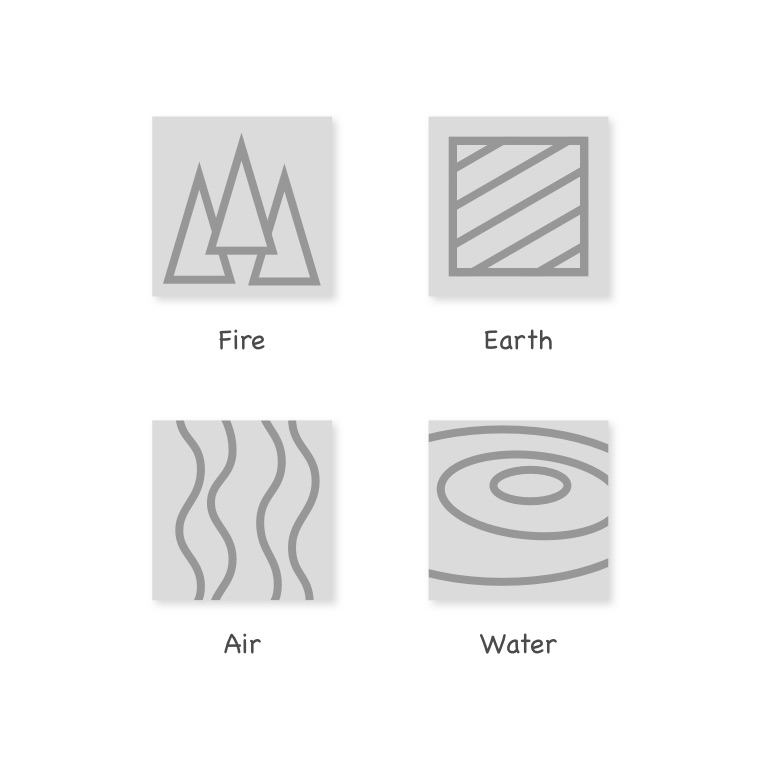The four Elements and their powers.

Along with the day & night cycle covered in the earlier post, the four elements is another foundation of the Western astrological chart.
The idea of the four elements and their qualities (or powers) presents a fascinating archetype that helps to dive deeper into the chart and see much more that appears on the surface.
A quick historical review
According to the classical model, every principle and object in the Creation is a compound made of the four basal elements, namely Fire, Earth, Water and Air.

It’s important to keep in mind that physical fire, earth, air and water — that we encounter on the planet Earth and the physical domain in general — are rather gross and distorted correspondences of the four elements. This should address the question of why plasma isn’t a part of those four. Plasma belongs to the physical domain and thus is a sibling of the elements.
Each element has its own proper quality — it’s an easy to remember set of correspondences:
| Element | Proper quality |
|---|---|
| Fire | Hot |
| Earth | Dry |
| Water | Cold |
| Air | Moist |
The principle of interconnection of the elements is described by the notion of mean quality. As the table below shows, each element borrows the next element’s proper quality as its mean quality, highlighting a wonderful interconnectedness of the elements:
| Element | Proper quality | Mean quality |
|---|---|---|
| Fire | Hot | Dry |
| Earth | Dry | Cold |
| Water | Cold | Moist |
| Air | Moist | Hot |
A deeper look at the Elements
There were some interesting contributions by philosophers that further enhanced the base model.
The Stoics introduced grouping of the elements into the categories that became known as “actives” and “passives”.
| Element | Category | Qualities |
|---|---|---|
| Fire and Air | Active | Light |
| Water and Earth | Passive | Heavy |
Plato had the idea of the unity of contrasts that is based on the following polarities:
- bright – dark
- thin – thick
- moving – quiet
The principle of unity of contrasts is expressed as a mutual relationship between the elements, from the lightest to the heaviest:
Fire to Air is what Air to Water is what Water to Earth.
This means that each consecutive element “borrows” some qualities of its predecessor. The table below illustrates this point.
| Element | Contrast 1 | Contrast 2 | Contrast 3 |
|---|---|---|---|
| Fire | Brightness | Thinness | Motion |
| Air | Darkness | Thinness | Motion |
| Water | Darkness | Thickness | Motion |
| Earth | Darkness | Thickness | Quietness |
This brought forward the idea, attributed to Hermes, that Fire and Earth are the two foundational opposing elements and, generally speaking, these two elements are “enough” to operate on — leaving Air and Water as intermediary elements that emerge as operational sub-products.
The Three Orders and the place of astrology
The four elements model describes an ideal archetypal state which doesn’t really exist in its pure form, at least not on the plane Earth. It’s somewhat similar to the quantum physics theory dealing with inherent instability and elusiveness of subatomic particles.
The three orders of emanation describe how the elements combine and transmute on their way to the earthly plane:
The First Order — pure four elements in their unmixed state.
The Second Order — the four elements have been compounded but can still be returned to their original purity.
The Third Order — made out of twice compounded elements with the mixtures transformable one into another.
The First and Second Orders are not really meaningful for us as they are way too pure, hypothetical and extremely hard to reach and operate on.
The Third Order is the most useful state of the elements. This is pretty much the level at which astrology operates. Don’t get confused, the Third Order is still way more subtler than the physical realm made of matter that we can physically interact with via the senses of touch, smell, taste, etc.
The Third Order manifests as:
- astral magnetism
- vibration and attraction
- form, number and colour
- attributes of time, space and substance
And this is really the domain of astrological discipline.
4 Comments
Claudio Silvaggi
Very nice layout of information and helps me as I venture through Astrologos learning. Check out the free book by Ken Wheeler “Uncovering the Missing Secrets of Magnetism”. It’s all one on the same. Cheers, and keep up the great work. Love the app!
Christopher Gibbs
Exodus
Love Carmen
Stunning article!
dimeind wolf
i have the pawer of 3 of the elments water air and earth